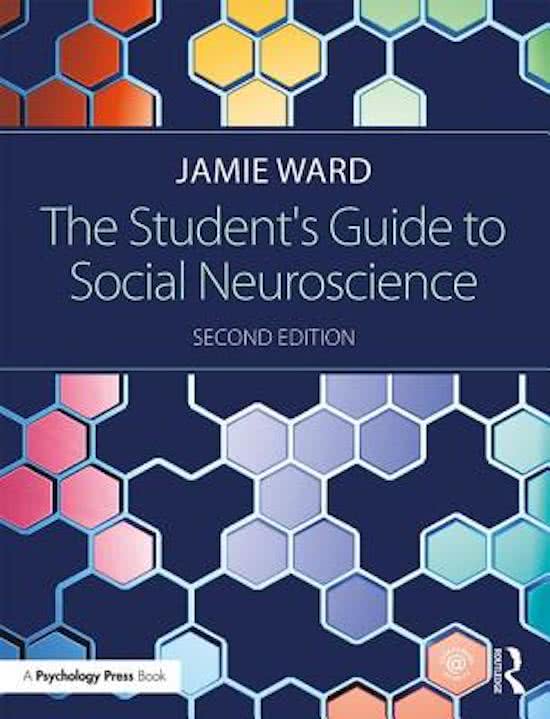Neuroscience (guest) lecture 5
Psychiatric examination
Biopsychosocial model
Bio: molescott: nature debate; everything is biologically determined
Psycho: you are who you think you are, if you really want it you can achieve it
Social: nurture debate; tabula rasa
Always take into account: developmental perspective and (sub)cultural
context
It’s the interaction between the person and his environment. The genes load
the gun, the environment pulls the trigger.
Illusion: misperception, je neemt een ware stimulus verkeerd waar (je neemt een
schaduw van een boom waar als een man met een stok)
Hallucinatie: je ziet dingen die er niet zijn en je gelooft ook echt dat dit er werkelijk is.
Hearing voices is not always abnormal
Pseudo-hallucinations: you know the hallucinations are not real
Important: there are no such things as isolated complaints or symptoms
Always take into account the context and level of interferences
ABC model
Antecedent: event or interactions that happen before behaviour occurs
Behavior: behaviour or sequence which has occurred
Consequence: events or interactions which happen after the behaviour
Gelijk aan 5 G’s model: gebeurtenis > gedachten, gevoelens, gedrag > gevolg
Personality disorders
Pattern of inner experience and behaviour that deviates from expectation of one’s
culture, pervasive and inflexible, onset in adolescence or early adulthood, stable over
time, leads to impairment or distress
Cluster A: odd, eccentric (paranoid (=very suspicious), schizoid (=very isolated),
schizotypal (=delusions and hallucinations, but not psychotic))
Cluster B: dramatic, emotional or erratic (borderline (=instability interpersonal
relationships, self-image, affects, marked impulsivity), antisocial, histrionic, narcissism)
Cluster C: anxious or fearful (avoidant, dependent, obsessive compulsive)
Voor verschil borderline en bipolar moet je terugkijken naar verleden maar ook
toekomst afwachten. Verschil is moeilijk. Het kan zelfs ook nog tegelijkertijd voorkomen.
,Neuroscience (guest) lecture 6
article
Je moet het model kennen uit de slides!
Adaptive functions of depression
communication a need for help
saving valuable resources
giving up commitment to unreachable goals
fitness advantage by inhibiting resourceful action which lead to nothing
the ability to feel bad an do nothing about is is an adaption
active coping: flight or fight response
passive coping: avoidance, heightened immobility related to development of clinical
depression
sympathic and parasympathic; rapid withdrawal and approach actions > evolution of
flight/fight system
triune brain; reptile – rodent – primate
how the brain is built during evolution
mother child bonding, early trauma, maternal deprivation > complex hormonally
regulated social bonding system. Predispose withdrawal (depression) non-adaptively.
depression is a disorder of social pain
what helps most: social support, opioids (but highly addictive and disabling)
monoamine theory of depression: suggests that depression result from functionally
deficit monoaminergic (5-HT / norepinephrine) transmission in the central nervous
system. Underactivity of serotonin and norepinephrine.
Critics: If depression is caused by a deficiency, then anti-depressants/SSRI’s should
work
Evidence actually contradicts these claims, they don’t have a deficiency of serotonin, but
an overload of serotonin. So serotonin has nothing to do with depression and anti
depressants don’t cure depression. Long term effects of anti depressants are bad,
especially in children.
Depression and HPA axis
Hypothalamus (CRH)> anterior pituitary (ACTH)> adrenal cortex (cortisol) > negative
feedback hypothalamus and anterior pituitary. When this doesn’t work (negative
feedback) your cortisol levels stay high.
Sleep deprivation is a short term depression killer. Sleep deprivation breaks the
connection between the limbic and cognitive system
Lithium for bipolar disorder, reduces severity and frequency of manic and depressive
episodes, significantly reducing suicide risk.
, In Afrika minder depressie, mogelijke verklaringen:
1. social differences: they think in terms of UBUNTU: the essence of being human. A
person is a person through other people. Individualism is extreme and also prevalence
in US.
2 . stereotypes: white people are weak, fearful and depressed, black people are strong,
fearless and happy. Depression doesn’t even exist in Xhosa (African language)
vocabulary. And there’s a tendency in young white people to seek diagnoses of mental
disorder.
3. Neanderthal genetics: recent published; we went out of Africa and met neanderthals,
genetic material suggests interbreeding with Neanderthals females > still in our genes?
Neanderthal genes linked to modern diseases, like risk for depression. Black people
never left Africa so didn’t meet Neanderthals? Idk snap het niet
4. environment/climate: veel zon > weinig depressive
Zorg dat je dat model kent (zie slides) en dat je het kunt toepassen op verschillende
stoornissen (behalve genetic variation). And be able to discuss its basics!!
Social environments strongly influence genetic, brain structure and function cognition
and behavior, while symptoms and disorders influence social environments.
Always take developmental stage into account






